Emerging Farming Systems in Western Himalaya: A State Level Analysis of Sustainability
Arnab Roy* and Uday Kumar
University of Agricultural Science, GKVK, Division of Agricultural Economics, India
Submission: February 18, 2018; Published: March 12, 2018
*Corresponding author: Arnab Roy, University of Agricultural Science, GKVK, Division of Agricultural Economics, Bangalore, India; Tel: 09475452924; Email: royarnab_94@rediffmail.com
How to cite this article: Arnab R, Uday K . Emerging Farming Systems in Western Himalaya: A State Level Analysis of Sustainability. Int J Environ Sci Nat Res. 2018; 9(2): 555757. DOI: 10.19080/IJESNR.2018.09.555757
Abstract
This paper examines the role of different components in promotion of Integrated farming systems and the benefits realized by the farmers in Western Himalaya. Integrated farming systems are now a day’s major practice that has high potential in hill areas. It is an extension of cropping systems, but with the introduction of perennials together with annual crops. Agricultural wasteland has to be brought under tree-based systems. Under rained condition, mono-crop of cereals (rice, wheat, maize) may give net return of Rs 9,000 to 10,000 per ha, a catchuprabi of pulses and oilseed increases net returns to about Rs 12,000 per ha. Rice-wheat under irrigated conditions can fetch about Rs 25,000 per ha against which vegetable crops can give net returns 4 to 8 times. The area covered under protected cultivation by the NHM has shown that of the total protected cultivation area, 20 per cent is under greenhouses and only 2 per cent is under fan and pad operated greenhouses. Small farmers spend most of their increased income on consumption while large farmers make non-farm investments.
Keywords: Farming systems; Rain fed; Mono-Crop; Western Himalaya; Greenhouses
Introduction
Western Himalaya refers to the western half of the Himalayan Mountain region, stretching from Badakhshan in northeastern Afghanistan/southern Tajikistan, through India (Jammu and Kashmir, Himachal Pradesh, Uttarakhand) to central Nepal. The Jhelum River rises in the PirPanjal Range in Jammu and Kashmir state, India, and flows northwestward through the Vale of Kashmir before entering the Pakistani-administered sector. The highest point is Nanga Parbat (26,660 feet or 8,126 meters), at the northwestern end of the region. Dalhousie, in Himachal Pradesh in the foothills of the range, is a noted hill station.
Climate and Rainfall in Western Himalayan Region
It shows great variation in relief. Summer season is mild (July average temperature 5°C-30°C) but the winter season experiences severe cold conditions (January temperature 0°C to -4°C). The amount of average annual rainfall is 150 cm. Zonal arrange-ment in vegetation is found with varying height along the hill slopes. Valleys and dons have thick layers of alluvium while hill slopes have thin brown hilly soils. The region is gifted with a number of perennial streams due to high rainfall and snow- covered mountain peaks of which Ganga, Yamuna, Jhelum, Chenab, Satluj and Beas etc. are worthy of mention. These provide irrigation water to canals and cheap hydel power for agriculture and indus-tries.
Important soil types
While Ladakh and parts of Lahaul and Spiti have skeletal, calcareous soils with alkaline reaction, the rest of the region have soils which are shallow to deep loamy, forest and podzolic brown with medium to high organic matter and acidic in reaction.
Agricultural and Horticultural practice in W-H region
Rice is the main crop of this region which is cultivated in terraced fields along the hill slopes. Maize, wheat, potato, barley are other important crops [1,2]. Temperate fruits like apple and pear etc. are produced in some parts of Jammu and Kashmir and Himachal Pradesh. Similarly tea plantations have started in some areas of Garhwal-Kumaun hills. The horticulture of the region is obsessed with the prob-lems of financial crisis, long gestation period, lack of improved varieties of plants and high post-harvest losses (about 20 % in packing, storage, marketing and processing).The region has favorable climatic conditions for growing temperate vegetables, flowers, and crops like ginger and saffron. In order to meet the requirement of fuel and fodder, a total area of 30,240 sq. km will need to be afforested in the next 10-15 years.
Temperate Zone in Western Himalayas
The temperate zone (Figure 1) in western Himalayas corresponds to zone III drawn up on agro-ecological basis by the planning commission. It is physio graphically a largely mountainous tract (1800-2000 m amsl).
Bio-physical features
This zone is characterized by mountainous tracts of varying altitudes, steep slopes etc. A calendar year is generally divided into three main seasons viz. winter (October-February), summer (March-June) and monsoon (July-September) with a brief spring (mid February-March) and autumn (late September- October). Winter temperatures generally remain below 5°C and precipitation in the form of both rainfall and snow result from the western depression. The cold wave sets the migration of the nomadic shepherds to warmer valleys in the Himalayan foothills. Summer temperatures remain above 20°C especially during April-June. The relative humidity remains about 40 per cent and the occasional hailstorms are known to cause extensive crop damage especially to apple, plum, apricot and peach Sen 1983 Rainfall during this period amounts to approximately 30 per cent of total annual rainfall (Figure 2).

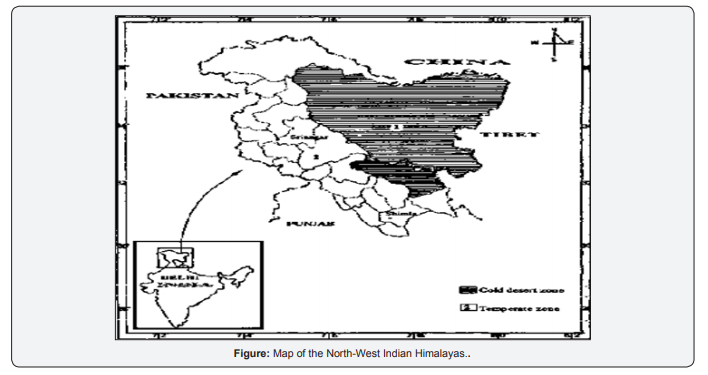
Farming System
Agro forestry is another practice that has high potential in hill areas. It is an extension of cropping systems, but with the introduction of perennials together with annual crops. Agricultural wasteland has to be brought under tree-based systems. Among the options for agro forestry are high density plantations of fruit trees [3]. An example of this is an agro forestry model on 2.0 ha land demonstrated in the Garhwal hills where multipurpose trees were in tercropped with turmeric and cardamom. Similarly, in Chamoli district, species suchas Alnusnepalensis and Dalbergiasissoo have been included in different plantations.
Livestock and Poultry Production
The contribution that livestock production can make towards enhancing socio-economic status of hill farmers is well recognized. In this regard, goat keeping and back yard poultry are ideally suited for small holdings. Unfortunately, well focused programmes for their promotion are not much evident [4,5]. The forward linkages for marketing have concentrated on milk. Marketing channels for goat, rabbit and poultry products have remained largely traditional and are ill equipped to handle larger volumes UNDP [6]. Even in the case of dairy, value added products like ghee are neglected. The organic nature of animal products in Uttarakhand are not emphasized enough to create a niche market for them. Under rain fed condition, mono-crop of cereals (rice, wheat, maize) may give net return of Rs 9,000 to 10,000per ha, a catchuprabi of pulses and oilseed increases net returns to about Rs 12,000 per ha. Rice-wheat under irrigated conditions can fetch about Rs 25,000 per against which vegetable crops can give net returns 4 to8 times. Three crops of vegetables can be taken during the season, the important rotations being [7,8]; (Table 1).
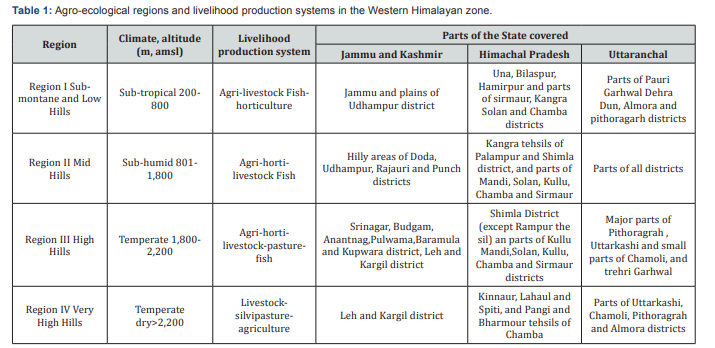
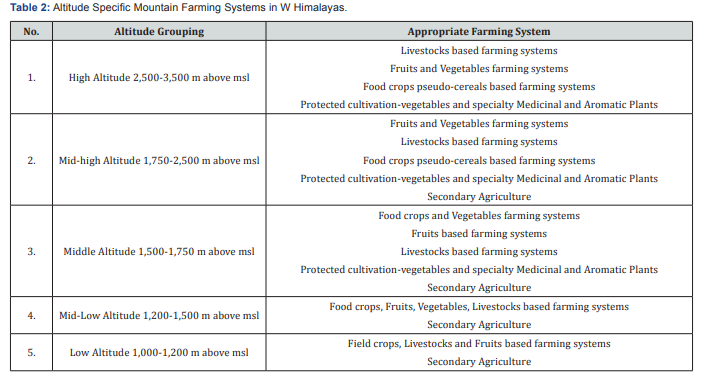
a) Tomato-tomato-cauliflower.
b) Tomato-cauliflower-radish, cabbage.
c) Cabbage-cauliflower French bean-French bean cauliflower.
d) Capsicum/brinjal-cabbage-radish, tomato-pea (Table 2).
Feeds and Fodders
Equipment for harvesting of fodder crops, hay baling making silage, feed blocks and feed pallets will be required to be introduced and popularized in future. For efficient use of scarce fodder, feeding chopped fodder should be popularized.
Biomass ManagementTo support organic farming equipment for mechanized composting, compost palliation, handling, transport and application of manure in the field in liquid and solid forms will be required. Such equipment will be required to be imported/ adopted/developed and popularized ( Tables 3 & 4).
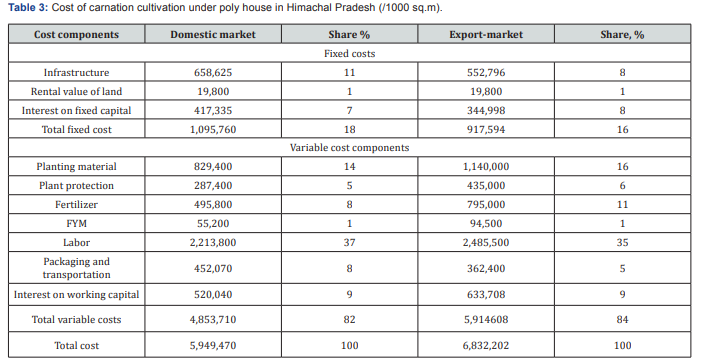
Cost of Cultivation of different IFS model.
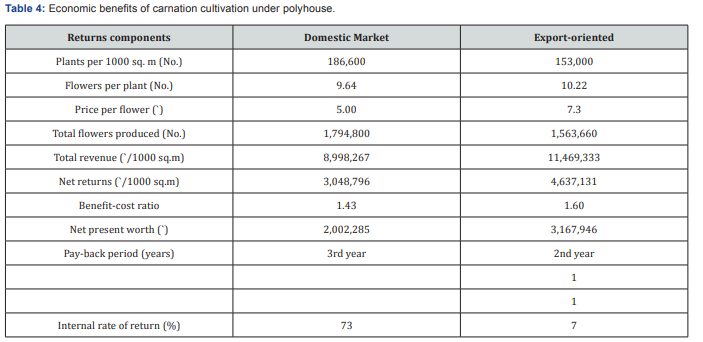
On-farm Post Harvest Technology
Post harvest equipment and technology are needed for cleaning, grading, drying, cooling, evaporative cooling, storage, cold storage and handling of farm produce to improve their quality and shelf-life.
Infrastructural facilities available in the Zone
Rural electrification
While all villages have been electrified in J&K and Himachal Pradesh, only 79 % of Uttaranchal villages have been electrified. However the electric supply is poor and there are frequent cuts.
Research and Training
The region has 12 ICAR Institutional Centers, four Agricultural Universities and one University of Horticultureand Forestry, a large number of research stations and sub-stations and 23 KVKs.
Swot Analysis of Mechanization Programmed in the Region
Strengths
Manufacturing of agricultural machineries and farm tools, implements especially through village. Tradition of custom servicing and hiring exists in the region's artisans, is gaining momentum.
Weaknesses
Land holdings are very small, topography is undulating and terraced irregular shape field's makes mechanization difficult with farm equipment available in the market. Mechanization has still not reached in many of the agricultural and produced management activities because of poor extension in the field of mechanization and agro-processing.
Opportunities
Farmers are keen to have improved tools, implements and machines. Mechanization minimizes drudging to farm workers and removes social taboos associated with certain farm operations thereby facilitating rural educated youth taking agriculture as vocation.
Threats
Failure to carry out a systematic mechanization programmed in Western Himalayas may result in reduced production, productivity and quality of field and horticultural crops. Stunted rural economy and political vulnerabilities.
Conclusion and Policy Issues
The study has shown substantial increase in the area and production of crops grown under protected structures. The floriculture in India is identified as a sunrise industry and the Government has accorded it export-oriented status. The area covered under protected cultivation by the NHM has shown that of the total protected cultivation area, 20 per cent is under greenhouses and only 2 per cent is under fan and pad operated greenhouses. Small farmers spend most of their increased income on consumption while large farmers make non-farm investments. Thus, protected cultivation has made a significant impact on farm households in the hilly region. However, further expansion of protected cultivation will depend on the effectiveness of supporting institutions and market structure.
References
- Neeraj Vedwan, Robert, E Rhoades (2001) Climate change in the Western Himalayas of India: a study of local perception and response. Climate Research 19: 109-117.
- Shah SL (1982) Ecological degradation and future of agriculture in the Himalayas. J Agric Econ, India 37(1): 1-22.
- Vosti SA, T Reardon, W Von Urff (1991) Agricultural Sustainability, Growth and Poverty Alleviation: Issues und Policies. (Eds.) German Foundation for International Development Feldafing, Germany, Europe.
- Sharma LR, R Chand, JP Bhati (1989) Farmers' dependence on forest for fuel wood, fodder and timber. Agric. Situation in Himachal Pradesh, India 40(7): 611-616.
- Sharma LR, JP Bhati, R Singh (1991) Emerging farming systems in Himachal Pradesh: Key issues in sustainability. J Agric Econ 46(3): 422-427.
- (1991) United Nations Development Programmed (UNDP). Human Development Report, Oxford University Press, England.
- Sen A, Chander M (2003) Disaster management in India: A Future Vision Employment News 27(24): 1-2.
- Swarup R, BK Sikka (1983) Development of horticulture and conservation of forests in Himachal Pradesh: Need for integrated approach. In: Development of Hill Areas: TS Papola (Eds.), Himalaya Book House, Bombay, India pp. 369-379.






























